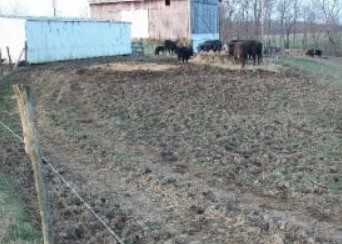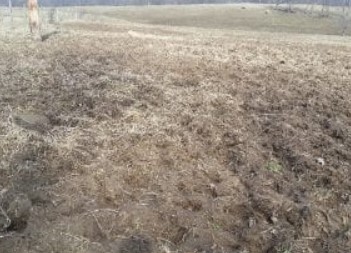
The dilemma: to add seed, or not to add seed?
If we do nothing but give the areas time, forage will grow. What forage grows will be determined by, how badly the area was tracked-up, the variety of seed dormant in your soils and your pastures fertility levels. It certainly seems we all have weed seed waiting and ready to grow if given the opportunity. So, what is a weed? In pesticide classes over the years, I’ve heard and I’ve said, “a weed is a plant growing out of place”. Luckily, for us, our livestock can utilize many weeds that grow in our pastures and get a good amount of nutrition from them, but a little extra help may be needed this year.
I think our job now, in these moderately to heavily tracked areas, is to determine, as best we can, what is going to come back in these torn-up fields. Then we can provide assistance where we deem necessary to help retain, or obtain, the species of forage we want in those fields. Where heavily pugged fields and tracking with machinery have occurred, complete renovation is probably going to be needed. Other areas with moderate damage might be smoothed with a drag or other implement when the soil firms enough to get equipment on it and then seed the area with a no-till drill (This can take place on partially frozen ground as well as dry soil). In the lightly tracked areas frost seeding should prove very beneficial to producers. This would also be a great time to increase the percentage of legumes and or grass varieties in your pastures.

This is the field pictured above, late in the spring after it was lightly disced, dragged, and had no seed added.
Frost seeding is a relatively inexpensive and quick way to incorporate new seed varieties or cultivars into a paddock. Light tracking from our livestock’s hoof action has provided the openings needed for the seed to make good contact with the soil in many pasture this year. Any producer wanting to use the frost seeding technique needs to put the seed on now, or in the next couple of weeks. As the name implies, frost seedings need freeze and thaw cycles after seed application to work properly. I always get producers asking me in mid/late March if they can still do frost seedings. My answer is generally, yes, you can still put the seed down, but if you don’t get several frosts after seeding, the results are probably not going to be what you want. So, if you have areas you want, or need to frost seed, do it now!
Getting back to our moderately damaged areas where complete renovation may not be needed, but we feel we still need to do something to reduce weed pressure, introducing a quick germinating variety of seed such as Italian ryegrass can be beneficial. These seeds start quickly and may help shade out unwanted weeds. This seed may be introduced by frost seeding methods we just discussed or by no-till drilling the seed into the soil.
Finally, as growth begins in the spring, new legume and grass seedlings will have a better chance to survive if they have help competing against the established plants. Frost seeded pastures should be grazed lightly or clipped in the spring at regular intervals when grass plants are ±8 inches in height. This will allow sunlight to enter the canopy so new legume seedlings are not shaded out. However, do not allow animals to graze newly seeded areas so heavily (to heights <3 inches) that they ruin the seeding before adequate roots are developed. Temporary electric fence may be needed to control livestock and prevent overgrazing. Strict grazing management to allow plants an adequate rest period after each grazing pass must be implemented to produce strong root systems and maintain healthy plant growth. If continuous unmanaged grazing is allowed to occur, your frost seeding efforts will be pointless.
If legume frost seeding’s were made in hay fields, do not apply high rates of nitrogen fertilizer to first cutting hay. Established grass plants, in mixed grass/legume stands, will out-compete the newly seeded legume plants and shade them out. Plan to make first cutting hay, on any frost seeded fields, early in the season (mid-May) if weather and field conditions permit. Grass height in second cutting hay will not be as much of a problem and new legume plants will be further development to compete better with the grasses.
Other articles on this Ohio Beef Cattle Letter site can help producers with seeding rates, fertility requirements, legume inoculation needs, as well as specie and variety suggestions that perform well in Ohio. The weather forecast for next week shows high temperatures just above freezing during the day and teens to low 20’s at night. Conditions are not going to get better than that. So, look at your fields, determine your needs and intentions for them, and get started on those repairs and frost seedings.
Source: osu.edu